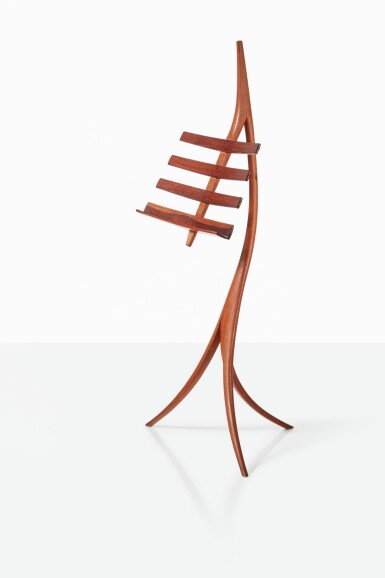
Property of a Private English Collector
Wendell Castle
Music Rack
Auction Closed
December 8, 09:48 PM GMT
Estimate
30,000 - 50,000 USD
Lot Details
Description
Property of a Private English Collector
Wendell Castle
Music Rack
1980
stack-laminated oak, rosewood
signed W. Castle and dated 1980
54⅜ x 25⅝ x 20 in. (138.1 x 65.1 x 50.8 cm)
Sotheby's New York, December 9th, 2005, Lot 284
Moderne Gallery, Philadelphia
R & Company, New York
Acquired from the above by the present owner
Wendell Castle and David Edman, The Wendell Castle Book of Wood Lamination, New York, 1980, pp. 74-87 (for a discussion of the production of the music rack)
Davira S. Taragin, Edward S. Cooke, Jr. and Joseph Giovannini, Furniture by Wendell Castle, exh. cat., Detroit Institute of Arts, 1989, p. 25, pl. 6
Alastair Gordon, Wendell Castle: Wandering Forms - Works from 1959-1979, exh. cat., The Aldrich Contemporary Art Museum, 2012, pp. 64 (for original sketches of the model) and 65 (for the present lot illustrated)
Emily Evans Eerdmans, Wendell Castle: A Catalogue Raisonné, 1958-2012, New York, 2014, p. 122, fig. II.252
“As I originally conceived the idea, the music rack would be an artistic investigation of a treelike form. The legs would be rootlike, embracing the ground in a gentle but regular, organic curve. From them the trunk would ascend like a supple, bent sapling. A twiglike appendage would descend to hold the easel.”
The music stand is a prime object of American studio furniture. It is an artifact of American postwar cultural history, when artistic communities mingled, and piano quintets were performed in the living rooms of the homes of professors in college towns. Wharton Esherick’s 1951 stand was the seminal design, and in Woodenworks, the inaugural exhibition of the Renwick Gallery in 1971, there were four examples of the form, by Esherick, Sam Maloof, Art Carpenter and Wendell Castle.
Although Wendell Castle was heavily influenced at the beginning of his career by the furniture of Esherick (and often told the story of attempting to visit the old master at his home in Chester County, Pennsylvania while on a road trip in 1959, only to be turned away at the door), he was adamant that his iconic music rack was not derived from Esherick’s model. Castle’s first wife, the mezzo-soprano Joyce Malicky Castle, enrolled in the graduate program of the Eastman School of Music when the couple moved to Rochester in 1962, and Castle began designing prototypes for her and other Eastman musicians.
By 1964, he had perfected the present model, and it quickly became his most famous design to date. A short film, “The Music Rack” was made by his friend, the photographer Tom Muir Wilson and widely shown at the time, and the design was selected by the textile artist Jack Lenor Larsen to be included in the American section of the 1964 Milan Triennale, where it received favorable press. In the legendary 1966 Life magazine article on the artistic goals of the new American craft movement, Castle was photographed by Nina Leen polishing a music rack in his studio.
Originally conceived in 1964 as an edition of twelve, Castle continued to make additional examples in the ensuing decades, in varying heights (for musicians ranging from cellists to harpists) and using different woods. Examples of the present music rack design are in the collections of the Museum of Arts and Design, New York; Art Institute of Chicago; Memorial Art Gallery, Rochester; Everson Museum, Syracuse; and the Museum of Fine Arts, Boston. Later variants are in the Smithsonian Museum of American Art and the Newark Art Museum.
-James Zemaitis
You May Also Like





